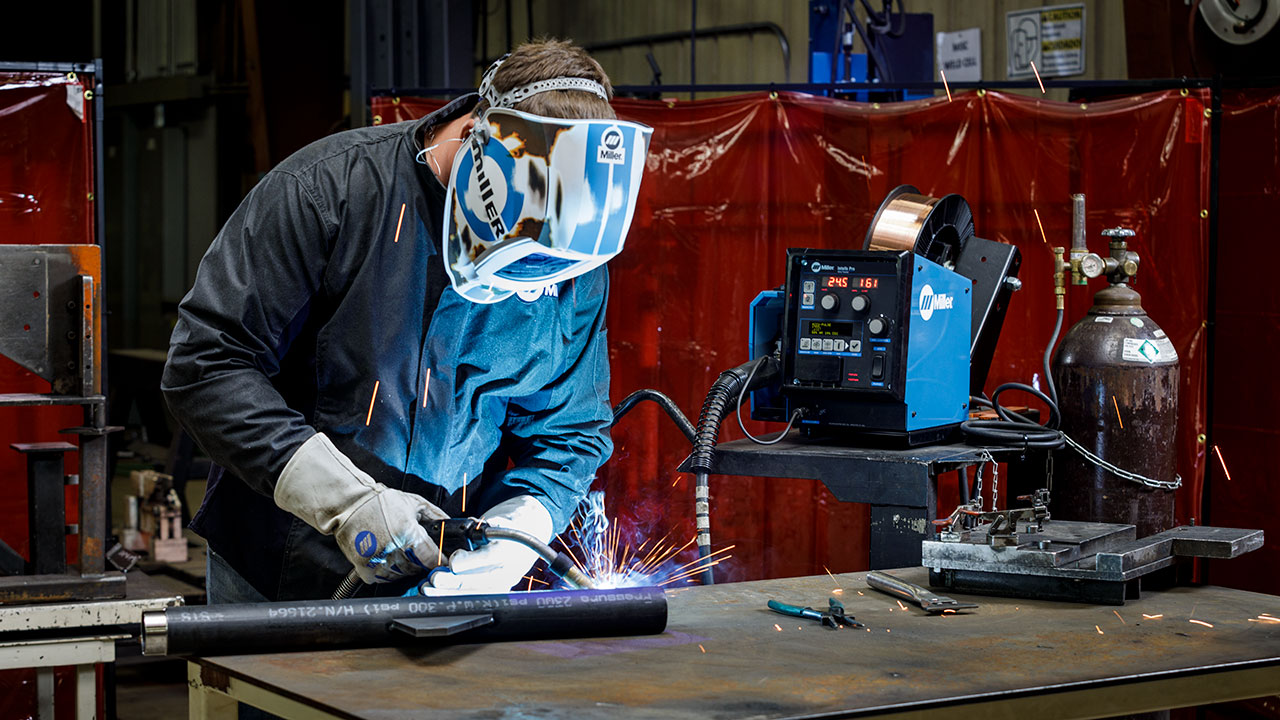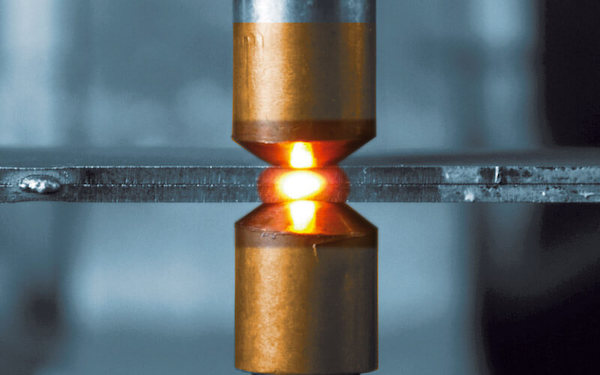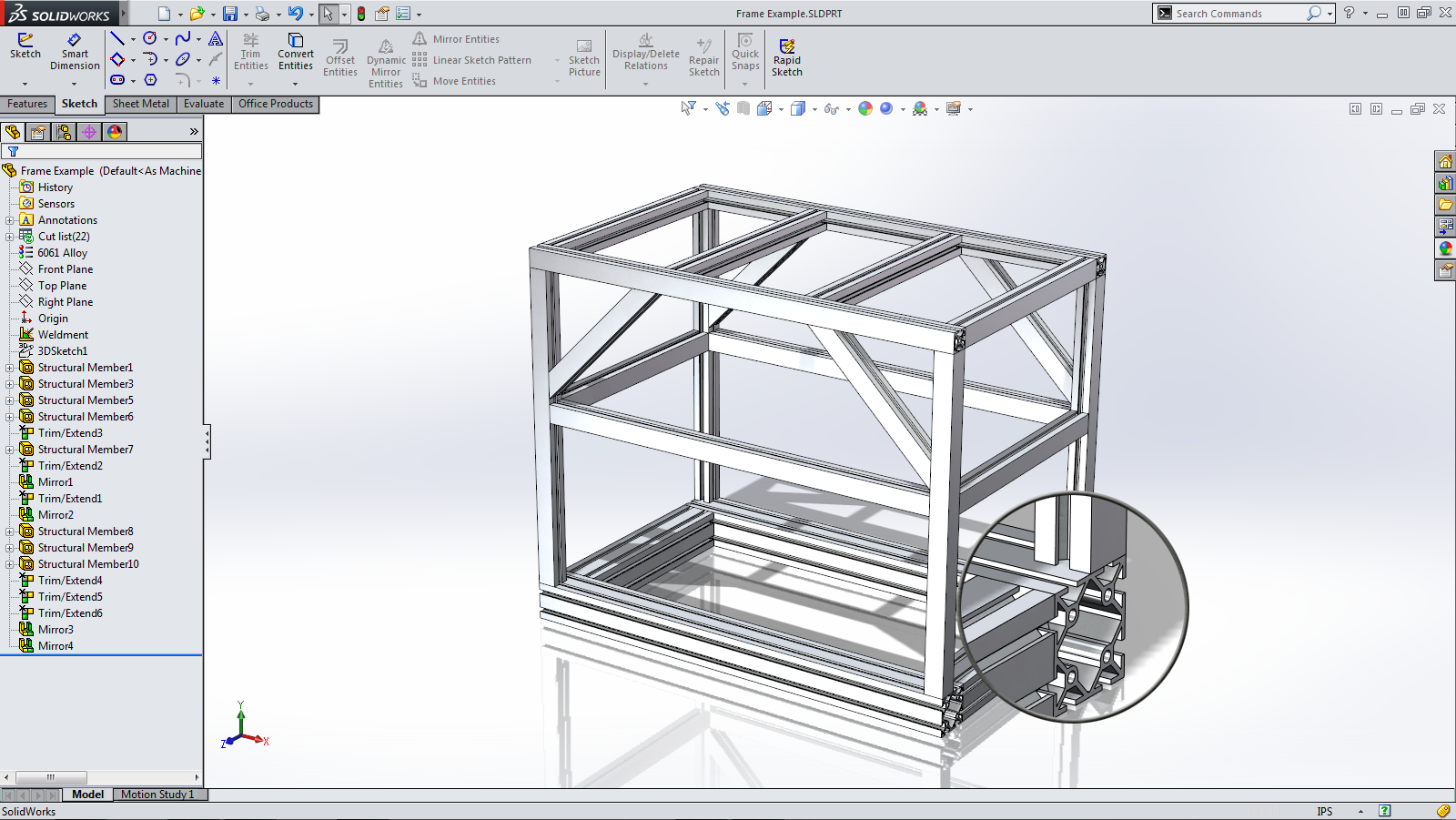Weldments
Table of Contents
Arc Welding [1] |
|---|
What are Weldments?
Welding is the process of joining metals by heating the surfaces to the point of melting by using a blowtorch, electric arch or many other methods [2]. After heating up the surfaces, the pieces are united through different methods, such as pressing or hammering [3]. The molten metal will then cool to form a joint, also known as a weldment. Carbon and low alloy steels are the most widely welded materials however, aluminium and its alloys are also weldable materials [4].
Common Welding Methods
There are various welding processes with unique techniques and applications which vary by industry. The primary processes include arc welding, friction welding, electron beam welding, laser welding and resistance welding, arc welding being the most popular [5]. The four most common methods of arc welding include Gas metal arc welding (MIG), Gas tungsten arc welding (TIG), Stick welding and Flux-cored arc welding [6].
Arc Welding
MIG Welding:
MIG welding is a very common method of welding. This method is used for a variety of different types of alloys and metals such as magnesium and copper [6]. In this process, a solid wire electrode is fed through a welding gun. An electric arc is formed between the base and the electrode, which heats the base and causes the material to melt and join [6]. A shielding gas is supplied, which protects the weld from nitrites and oxides, which could contaminant the weldments [6]. There are many advantages to using this method. It is the easiest welding technique, and can be used by entry level welders. There is a lower heat input requirement and the cleanup is quick and easy. MIG welding is commonly used for applications such as pipe welding, automotive production and maintenance, manufacturing, shipbuilding and construction [7].
TIG Welding:
In this method, a tungsten electrode, which is consumable, is used heat up the base of the metals and create a molten weld puddle on it [6]. An extra metal filter can be added to molten weld puddle to enhance the properties of the weldment. This method also needs an external gas supply to protect the puddle from contamination. Argon is the most common method for protecting the puddle [6]. There are also many different advantages to this welding method. TIG welding offers high quality weldments, and is clean without any splatters. Very thin materials can also be welded together using this method. The welder has tremendous control over the welding process, and this method is very accurate [6]. The weld beads produced in this process are highly aesthetic [6]. TIG welding is commonly used in the aerospace industry, automotive construction and repair, art, nuclear, pharmaceutical and ship fitting [7].
Stick Welding:
This type of welding is used for welding most ferrous metals and also other metal types by using a special electrode. A welding rod is sued to carry a current providing the majority of the metal weld. In this case, the metal and electrode are both being melted. This method is used for heavy equipment, construction and repairing [6]. One of greatest advantages of this method, is that it can used in rainy and windy conditions. The equipment required are also very affordable, and it requires no extra shielding supplies [6].
Flux-cored arc welding:
The process involves an electrode being continuously fed through a tubular wire filled with flux [6]. Flux-cored arc welding offers two processes, dual shield flux-cored welding and shielding flux-cored welding. Dual shield involves an externally supplied gas, which is used in conjunction with the electrode in shielding the molten welding puddle, whereas self shielding flux-cored welding requires no external gas to protect the weld [6]. Flux-cored arc welding is commonly used for pipeline welding, general repairs, shipbuilding, manufacturing and underwater welding [7].
Flux-cored arc welding [8] |
|---|
Friction Welding
Friction welding uses mechanical friction to heat and soften metals. The metals will then mix, and bond as they cool. Types of friction welding include rotary friction welding, linear friction welding, friction stir welding and friction stir spot welding [5]. Unlike other welding techniques, friction welding requires no filler metals, flux or shielding gas. Friction welding is used broadly across the industry and is even being explored as a technique to bond wood without adhesives [5].
Rotary Friction Welding [9] |
|---|
Electron Beam Welding
Electron beam welding is a fusion joining process in which a beam of high velocity electrons are used to join materials. The kinetic energy of the electrons is converted to heat as the electrons impact the workpieces, causing them to fuse together [5]. This technique has many common applications and it is used in various industries, including aerospace, nuclear, and automotive [5].
Resistance Welding
Resistance welding is split into two types, spot welding and seam welding. Spot welding is a process in which metal parts in contact are joined by heating them with an electric current [5]. Seam welding uses rotating wheels in place of electrodes to deliver heat to the metal surfaces. Resistance welding is commonly used in the assembly of bodies for automobiles and manufacturing of steel pipes [5].
Spot Welding [10] |
|---|
Forge Welding
Forge welding is a metal fusion technique that dates from the earliest uses of iron. This process was initially used to make small pieces of iron into larger pieces by joining them. The work pieces are first shaped, then heated in a forge and finally pressed or hammered together [4]. Forge welding has survived mainly as a blacksmith's craft and is used to some extend in chain making today [4].
Brazing
Brazing is also another process of joining metals where two or more metal items are joined by melting and flowing a filler metal into the joints. In brazing, the metal filler has a lower melting point then the metals being joined [11]. Brazing is different from welding in a few ways. This method does not require melting the work pieces [11]. One of the advantages of brazing is that it has the ability to join the same or different metals with great strength [11]. For high quality brazing, the parts must be closely fit and the base metals must be free of oxides [11]. Additionally, the brazing temperature should be above the the melting point of the filler metal. Some of the advantages of brazing include that it allows much tighter control over tolerances and produces a clean joint without the use of a secondary finish [11]. Brazing also produces less thermal distortion than welding since it uniformly heats the metals [11]. However, one of the disadvantages of brazing is the lack of joint strength compared to welding, since it uses a softer filler metal [11]. Additionally, the joint color may different from the metal color, which can create an aesthetic disadvantage.
Brazing [12] |
|---|
Welding Equipment
There are many different machines and equipment that can be used during the welding process. To start off, a welding station is a set of welding equipment that require participation from the welder [13]. A welding line combines many welding stations [13]. Welding stations include power supplies and equipment to regulate the arc during welding [13]. A welding transformer is used to match of the welding circuit and power supply, while also working as a voltage regulator [13]. A welding generator is another machine used during welding. This machine is a specifically designed electric machine, and is either a DC machine or a machine that operates at higher than standard frequencies [13]. There are also many different welding generators. Another piece of equipment is a welding rectifier, which converts alternating currents from a power supply to direct current [13]. Welding jigs and fixtures are used by welders to assemble parts before the welding process starts, to hold parts in place, and to weld previously assembled parts [13]. These parts can be held together with screws and magnetic clamps [13]. Finally, there are many different welding tools. Welders often use electrode holders, welding torches, cleaning tools like hammers, wire brushes, and many other tools [13].
Welding Torch [13] |
|---|
Joint Configurations
| Butt Joint | T Joint | Corner Joint | Edge Joint | Cruciform Joint | Lap Joint |
|---|---|---|---|---|---|
| The connection between the two edges/parts forms an angle of 135-180° [5]. | The connection between the end or edge of one part forms a 5-90° angle with the face of the another part [5]. | The connection between the ends or edges of two parts form an angle of 30-135° [5]. | The connection between the edges of two parts form an angle of 0-30° [5]. | The connection consists of two flat plates/bars which are welded to another flat plate at right angles, on the same axis [5]. | The connection between two overlapping parts form an angle of 0-5° [5]. |
Features of Completed Welds
Butt Weld Features [5] | Fillet Weld Features [5] |
|---|---|
| Feature | Description |
|---|---|
| Parent Metal | Metal to be joined by welding. |
| Filler Metal | Metal added during welding. |
| Weld Metal | All metal melted in the formation of a weld and retained in the weld. |
| Heat Affected Zone (HAZ) | Non-melted area of metal that has undergone changes in material properties [5]. |
| Fusion Line | Non-standard term to describe the boundary between the weld metal and the HAZ in a fusion weld [5]. |
| Weld Zone | Zone containing both the weld metal and the HAZ [5]. |
| Weld Face | Surface of a fusion weld exposed on the side from which the weld has been made. |
| Weld Root | Zone on the side of the first run, furthest from the welder. |
| Weld Toe | The boundary between a weld face and the parent metal or between runs. |
| Excess Weld Metal | Weld metal outside of the plane joining the toes [5]. |
| Run (pass) | The metal melted/deposited during a single passage of an electrode, torch or blowpipe [5]. |
| Layer | Stratum of weld metal consisting of one or multiple runs [5]. |
Testing of Weldments
A weldment must be tested to ensure the connection meets the applicable codes and standards. The five testing methods include:
- Visual Testing: A qualified observer will perform a simple visual inspection [3].
- Penetrant Testing: A colouring agent is used to detect for defective weldments [3].
- Magnetic-Particle Testing: Changes in a magnetic field detect for surface and just undersurface discontinuities [3].
- Ultrasonic Testing: A high-frequency sound wave is sent into the metal and the reflections of the sound waves are evaluated to determine if voids, cracks, or other defects are present within the weld [3].
- Radiographic Testing: X-Rays are used to examine the weld for defects [3].
Welding Standards
Many aspects of the design and fabrication of welded components are governed by codes and standards. These codes and standards are often specified by end users in order to control aspects of the welded fabrication which may affect service requirements [14]. They are also used by manufacturers to help with the development and implementation of their welding quality system [14]. There are various committees within national and technical societies which continue to develop new welding codes and standards based on industry needs. To learn more about standards and where you can access them, please see: Mechanical Standards.
What the Welding Code and Standard Provides
Welding codes and standards will vary in content and requirements, however there are a number of common elements such as the scope and general requirements, design, qualification, fabrication, and inspection. The scope and general requirements, which is found at the beginning of the document generally provide a description of the type of welding fabrication for which the document is intended to be used [14]. It may also provide information as to the limitations of use of the document. The design section may refer the user to a secondary source or provide minimum requirements for the design of specific welded connections [14]. The qualification section describes the requirements for qualification testing of welding procedure specifications (WPS) [14]. Additionally, it may provide essential variables which govern the extent of qualification. These variables include welding processes, type and thickness of base metal, filler metal type and others [14]. The fabrication section generally provides information about the fabrication methods and/or workmanship standards [14]. Finally, the inspection section addresses the welding inspector's qualification requirements and responsibilities, the acceptance criteria for discontinuities and requirements pertaining to non-destructive testing [14].
Canadian Standards Association (CSA)
The following table includes a list of CSA standards specific to welding with corresponding outlines.
| Standard Number | Description |
|---|---|
| CAN/CSA-G401-14 | Corrugated steel pipe products [15] |
| CAN/CSA-ISO 14341:11 (R2016) | Welding consumables - Wire electrodes and weld deposits for gas shielded metal arc welding of non alloy and fine grain steels - Classification [15] |
| CAN/CSA-W117.2-12 | Safety in welding, cutting, and allied processes [15] |
| G40.20-13/G40.21-13 | General requirements for rolled or welded structural quality steel/ Structural quality steel [15] |
| W178.1-14 | Certification of welding inspection organizations [15] |
| W178.2-14 | Certification of welding inspectors [15] |
| W47.1-09 (R2014) | Certification of companies for fusion welding of steel [15] |
| W47.2-11 (R2015) | Certification of companies for fusion welding of aluminum [15] |
| W48-14 | Filler metals and allied materials for metal arc welding [15] |
| W55.3-08 (R2013) | Certification of companies for resistance welding of steel and aluminum [15] |
| W59-13 | Welded steel construction (metal arc welding) [15] |
| W59.2-M1991 (R2013) | Welded Aluminum Construction [15] |
| CAN/CSA-Z662-15 | Oil and gas pipeline systems [15] |
Safety Considerations
Welding Hazards and Safety Risks
Welding is a hazardous workplace activity which poses numerous health and safety risks. The four primary hazards and safety risks include, exposure to fumes and gases, physical hazards, electric shock, fire and explosion [16].
- Exposure to Fumes and Gases: Overexposure to welding fumes can cause health problems such as respiratory illnesses, cancer and impaired speech and movement.
- Physical Hazards: Physical hazards can result in burns, eye damage, cuts, crushed toes and fingers.
- Electric Shock: Electrocution caused by a sudden discharge of electricity to the body is the most serious risk for a welder, that can result in serious injury and even death.
- Fire and Explosion: Flammable materials in the vicinity of the working area presents a high risk of a fire.
Safe Practices for Welders
Welding safety measures exist to protect employees from such hazards. It is important that workers are aware of safety precautions to minimize health and safety risks. Please note that all machine shop facilities and companies have their own safety practices, however, general safe practices include the following [16]:
- Wearing an approved respirator (unless exposure assessments are below applicable exposure limits).
- Inspecting welding equipment and electrode holder prior to work.
- Not touching metal parts of the electrode with skin or wet clothing.
- Wearing appropriate PPE, which includes welding goggles and a welding helmet to protect the welder's eyes and head from sparks, intense light and chemical burns.
- Remaining in the work area for at least 30 minutes after finishing, to ensure there are no smoldering fires.
To become familiar with the rules and standard operating procedure of the University of Waterloo's engineering student shops please see: Machine Shops Safety.
Additional Safety precautions:
- Provide sufficient ventilation and local exhaust to mitigate gases and fumes.
- Report concerns to a supervisor.
- Fire and electricity resistant clothing, hand shields, gloves, aprons and boots should be worn.
- Earmuffs/earplugs can protect the workers against noise [16].
SolidWorks: Weldments
Weldments allow you to easily design complex welded or bolted structural members as a single multibody part. To define the framework, simply use a 2D or 3D sketch [17]. Additionally, Gussets and end caps can be added using tools on the Weldments toolbar [17]. For more information, please see: SolidWorks Weldments [17].
SolidWorks: Weldments [18] |
|---|
References
[1] “Easy-to-use welding technology shortens welder training and reduces rework,” Millerwelds.com. [Online]. Available: https://www.millerwelds.com/resources/article-library/easy-to-use-welding-technology-shortens-welder-training-and-reduces-rework. [Accessed: 26-Feb-2021].
[2] “Welding and Joining Specialization,” Mechanical and Mechatronics Engineering, 10-Jan-2014. [Online]. Available: https://uwaterloo.ca/mechanical-mechatronics-engineering/future-undergraduate-students/mechanical-engineering/welding-and-joining-specialization. [Accessed: 24-Jan-2021].
[3] "Understanding Weldments | EDT Forensic Engineering & Consulting", Edtengineers.com, 2021. [Online]. Available: https://www.edtengineers.com/blog-post/understanding-weldments. [Accessed: 24-Jan- 2021].
[4] “Welding” Encyclopedia Britannica. https://www.britannica.com/technology/welding (accessed Feb. 05, 2021).
[5] “What is welding? - definition, processes and types of welds,” Twi-global.com. [Online]. Available: https://www.twi-global.com/technical-knowledge/faqs/what-is-welding. [Accessed: 05-Feb-2021].
[6] James, James, Tom, L. Smith, Rob, Maggie, B. McAvoy, James Thanks, James, Yolo, J. Jorgenson, J. Blackhull, B. Clyde, and D. Anderson, “The Common Welding Methods - Pros and Cons,” Welder Reviews, 28-Apr-2016. [Online]. Available: http://pickwelder.com/the-common-welding-methods-pros-and-cons.html. [Accessed: 09-Feb-2021].
[7] Z. Buel, “Your ultimate guide to every different type of welding,” Tws.edu, 05-Jun-2018. [Online]. Available: https://www.tws.edu/blog/welding/your-ultimate-guide-to-every-different-type-of-welding/. [Accessed: 26-Feb-2021].
[8] Thefabricator.com. [Online]. Available: https://cdn.thefabricator.com/a/getting-to-know-flux-cored-wires-0.jpg. [Accessed: 19-Feb-2021].
[9] Imgur.com. [Online]. Available: https://i.imgur.com/LHJVxUQ.gif?noredirect. [Accessed: 19-Feb-2021].
[10] “Resistance welding - weld guru,” Weldguru.com, 28-Nov-2019. [Online]. Available: https://weldguru.com/resistance-welding/. [Accessed: 19-Feb-2021].
[11] “Brazing Process fundamentals: How to braze in six steps,” Brazing Fundamentals | Lucas Milhaupt. [Online]. Available: https://lucasmilhaupt.com/EN/Brazing-Academy/Brazing-Fundamentals.htm. [Accessed: 19-Feb-2021].
[12] Harris Products Group, “What metals can be brazed,” Harrisproductsgroup.com. [Online]. Available: https://www.harrisproductsgroup.com/en/blog/2017/february/what-metals-can-be-brazed.aspx. [Accessed: 19-Feb-2021].
[13] “Welding Equipment,” The Free Dictionary. [Online]. Available: https://encyclopedia2.thefreedictionary.com/Welding+Equipment#:~:text=The%20welding%20equipment%20includes%20the,welded%20articles%2C%20auxiliary%20equipment%20used. [Accessed: 25-Feb-2021]
[14] “What you should know about welding codes and standards,” Esabna.com. [Online]. Available: https://www.esabna.com/us/en/education/blog/welding-codes-and-standards.cfm. [Accessed: 25-Feb-2021].
[15] “Welding industry - CSA Group,” Csagroup.org, 07-Sep-2020. [Online]. Available: https://www.csagroup.org/store/welding-industry/. [Accessed: 25-Feb-2021].
[16] “Welding safety & welding hazards,” Safetyculture.com, 07-Jul-2018. [Online]. Available: https://safetyculture.com/topics/welding-safety/. [Accessed: 12-Feb-2021].
[17] "2019 SOLIDWORKS Help - Weldments", Help.solidworks.com, 2021. [Online]. Available: https://help.solidworks.com/2019/english/SolidWorks/sldworks/c_Weldments_Overview.htm#:~:text=Weldments%20functionality%20enables%20you%20to,to%20define%20the%20basic%20framework.&text=When%20you%20create%20the%20first,to%20the%20FeatureManager%20design%20tree. [Accessed: 26-Jan- 2021].
[18] J. Regnerus, “Throwback Thursdays: Weldments,” Solidworks.com, 12-Jun-2014. [Online]. Available: https://blogs.solidworks.com/tech/2014/06/throwback-thursdays-weldments.html. [Accessed: 05-Feb-2021].






